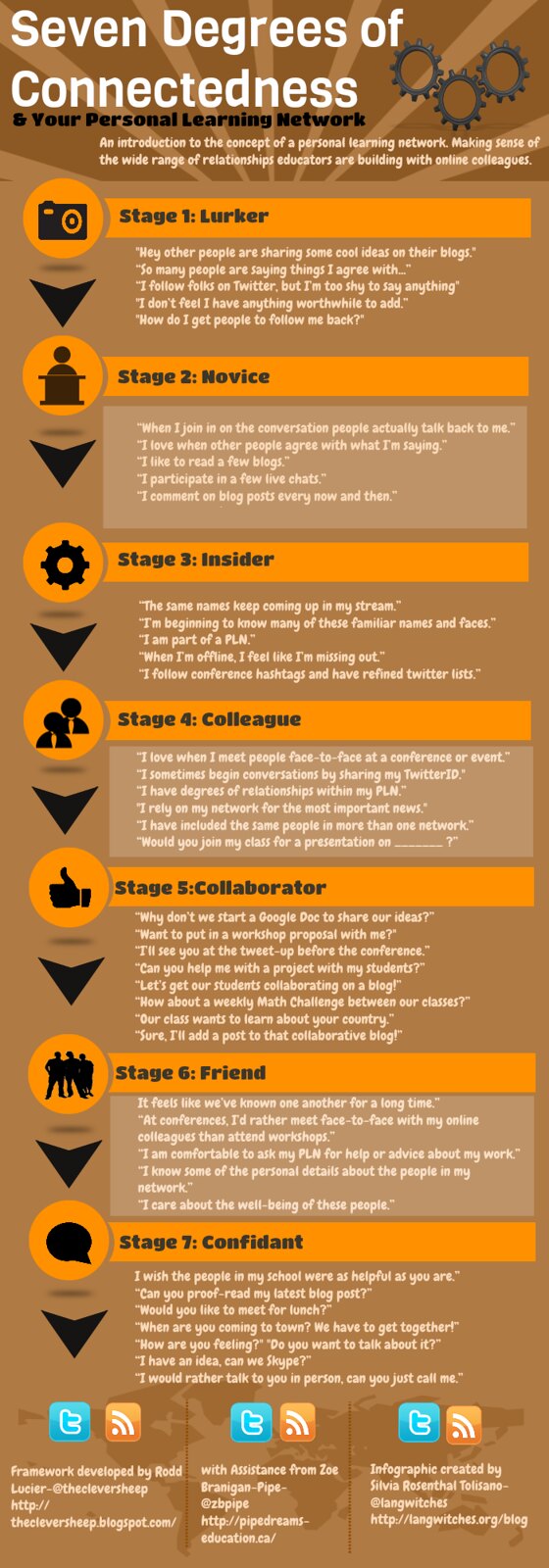Teachers tend to work in isolation on their own islands, keeping their learning to themselves, yet they also generously share resources with one another. It is this latter trait that is becoming increasingly important as the role of the educator continues to expand. As educational technology research specialist Stephen Downesobserves, the expectations on teachers have grown from "being expert in the discipline of teaching and pedagogy...[to needing to have] up-to-date and relevant knowledge and experience in it. Even a teacher of basic disciplines such as science, history or mathematics must remain grounded, as no discipline has remained stable for very long, and all disciplines require a deeper insight in order to be taught effectively." It is no longer possible for an educator to work alone to fulfil each of these roles: the solution is to work and learn in collaboration with others. This is where peer-based sharing and learning online, connected/networked learning, or peeragogy, can play an important role in helping educators.
Becoming a connected/networked learner
The following steps are set out in 'phases' in order to suggest possible experiences one may encounter when becoming connected. It is acknowledged that every learner is different and these 'phases' only serve as a guide.
Phase 1: Deciding to take the plunge
To help educators begin to connect, theConnected Educator's Starter Kit was created during Connected Educator's Month in August 2012. This chapter previews the main steps. The first step to becoming a 'connected educator-learner' involves making the commitment to spending the time you'll need to learn how to learn and share in an open, connected environment.
Phase 2: Lurking
We start off as lurkers. A learner can be considered a true 'lurker' after reviewing the starter kit, establishing a digital presence (through a blog or a wiki) or signing up for Twitter and creating a basic profile containing a photo. In this phase, lurkers will begin to'follow' other users on Twitter and observeeducational Twitter 'chats'. Lurkers will also begin to seek out other resources throughblogs,Facebook,Edmodo andLinkedIn groups.
Phase 3: Entering the fray
The lurker begins to develop into a connected educator-learner once he or she makes the decision to enter into a dialogue with another user. This could take the form of a personal blog post, participation on an education-relatedblog orwiki or an exchange with another Twitter user. Once this exchange takes place, relationships may begin to form and the work towards building a Personal Learning Network (PLN) begins.
One such site where such relationships can be built isClassroom 2.0, which was founded bySteve Hargadon. Through Classroom 2.0, Steve facilitates a number of free online learning opportunities including weeklyBlackboard Collaborate sessions, conferences, book projects and grassroots cross-country educational-transformation tours. Classroom 2.0 also offers a supportive Social Ning---a free, social learning space that provides online conferences and synchronous and recorded interviews with inspirational educators---for connected educator-learners around the world.
Phase 4: Building and shaping your PLN
Just as not every person one meets becomes a friend, it is important to remember that not every exchange will lead to a co-learning peeragogy arrangement. It may be sufficient to follow another who provides useful content without expecting any reciprocation. It is dependent on each educator-learner to determine who to pay attention to and what learning purpose that individual or group will serve. It is also up to the learner-educator to demonstrate to others that he or she will actively participate.
There are a number ofstrategies one can use when shaping the PLN to learn. However, one of the best ways educators can attract a core of peeragogues is by sharing actively and demonstrating active and open learning for others.
There are a number of sites where a new educator-learner can actively and openly learn. In addition to personal blogging and wikis, other professional development opportunities include open, online courses and weekly synchronous online meetings through video, podcasts or other forms of media.
Examples include:Connected Learning TV,TechTalkTuesdays,VolunteersNeeded,SimpleK12,K12 Online,CEET, and EdTechTalk.
Alternatively, courses are offered withP2PU's School of Education or a wide variety of other opportunities collected byTeachThought and Educator's CPD online. Peggy George, the co-faciliator of the weekly Classroom 2.0 LIVE Sessions, created a livebinder package of free 'PD On Demand' connected professional development online options for peeragogy enthusiasts.
Phase 5: Extending the digital PLN and connecting face-to-face
Over time, once the connected educator-learner has established a refined PLN, these peeragogues may choose to shift their learning into physical learning spaces. Some options available for these educator-learners would include the new 'grassroots unconferences', which include examples such as: EduCon,EdCamps,THATcamp andConnectedCA.
These (un)conferences are free or extremely low-cost and focus on learning from and with others. These 'unconferences' are typically publicized through Twitter, Google Apps, and Facebook. Connecting face-to-face with other peeragogues can strengthen bonds to learning networks and help to promote their sustainability.
Postscript
Sylvia Tolisano, Rodd Lucier and Zoe Branigan-Pipen co-created an infographic
which explores the experiences individuals may encounter in the journey
to become connected learners through another related sequence of steps:Lurker, Novice, Insider, Colleague, Collaborator, Friend,
and Confidant. Googlize it, and have a look at ourRecommended Readings in
Chapter 31 for additional resources.
infographic
which explores the experiences individuals may encounter in the journey
to become connected learners through another related sequence of steps:Lurker, Novice, Insider, Colleague, Collaborator, Friend,
and Confidant. Googlize it, and have a look at ourRecommended Readings in
Chapter 31 for additional resources.